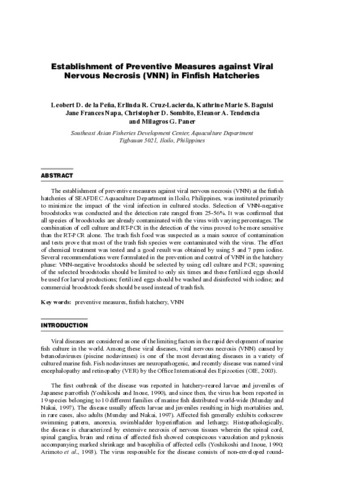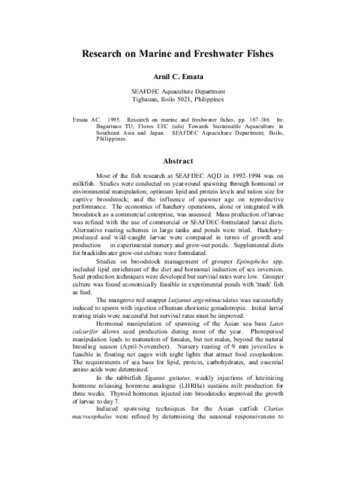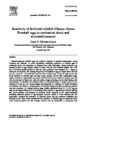Perlihatkan publikasi sederhana
Establishment of preventive measures against viral nervous necrosis (VNN) in finfish hatcheries
| dc.contributor.author | de la Peña, Leobert D. | |
| dc.contributor.author | Cruz-Lacierda, Erlinda R. | |
| dc.contributor.author | Baguisi, Kathrine Marie S. | |
| dc.contributor.author | Napa, Jane Frances | |
| dc.contributor.author | Sombito, Christopher D. | |
| dc.contributor.author | Tendencia, Eleonor | |
| dc.contributor.author | Paner, Milagros G. | |
| dc.contributor.editor | Nagasawa, Kazuya | |
| dc.date.accessioned | 2020-07-22T00:45:25Z | |
| dc.date.available | 2020-07-22T00:45:25Z | |
| dc.date.issued | 2005-03 | |
| dc.identifier.citation | de la Peña, L. D., Cruz-Lacierda, E. R., Baguisi, K. M. S., Napa, J. F., Sombito, C. D., Tendencia, E. A., & Paner, M. G. (2005). Establishment of preventive measures against viral nervous necrosis (VNN) in finfish hatcheries. In K. Nagasawa (Ed.), Recent Advances in Diagnosis and Prevention of Fish and Shrimp Diseases in Southeast Asia (pp. 115–125). Tigbauan, Iloilo, Philippines: Aquaculture Department, Southeast Asian Fisheries Development Center. | en |
| dc.identifier.isbn | 9718511732 | |
| dc.identifier.uri | http://hdl.handle.net/10862/5919 | |
| dc.description.abstract | The establishment of preventive measures against viral nervous necrosis (VNN) at the finfish hatcheries of SEAFDEC Aquaculture Department in Iloilo, Philippines, was instituted primarily to minimize the impact of the viral infection in cultured stocks. Selection of VNN-negative broodstocks was conducted and the detection rate ranged from 25-56%. It was confirmed that all species of broodstocks are already contaminated with the virus with varying percentages. The combination of cell culture and RT-PCR in the detection of the virus proved to be more sensitive than the RT-PCR alone. The trash fish food was suspected as a main source of contamination and tests prove that most of the trash fish species were contaminated with the virus. The effect of chemical treatment was tested and a good result was obtained by using 5 and 7 ppm iodine. Several recommendations were formulated in the prevention and control of VNN in the hatchery phase: VNN-negative broodstocks should be selected by using cell culture and PCR; spawning of the selected broodstocks should be limited to only six times and these fertilized eggs should be used for larval productions; fertilized eggs should be washed and disinfected with iodine; and commercial broodstock feeds should be used instead of trash fish. | en |
| dc.language.iso | en | en |
| dc.publisher | Aquaculture Department, Southeast Asian Fisheries Development Center | en |
| dc.subject | disease prevention | en |
| dc.subject | Epinephelus coioides | en |
| dc.subject | Lates calcarifer | en |
| dc.subject | Lutjanus argentimaculatus | en |
| dc.subject | Chanos chanos | en |
| dc.title | Establishment of preventive measures against viral nervous necrosis (VNN) in finfish hatcheries | en |
| dc.type | Book chapter | en |
| dc.citation.spage | 115 | |
| dc.citation.epage | 125 | |
| dc.citation.bookTitle | Recent Advances in Diagnosis and Prevention of Fish and Shrimp Diseases in Southeast Asia | en |
| dc.subject.asfa | hatcheries | en |
| dc.subject.asfa | necrosis | en |
| dc.subject.asfa | mariculture | en |
| dc.subject.asfa | fish culture | en |
| dc.subject.asfa | fish diseases | en |
| dc.subject.asfa | histopathology | en |
| dc.subject.asfa | breeding stock | en |
| dc.subject.asfa | viruses | en |
| dc.subject.asfa | nucleic acids | en |
| dc.subject.asfa | fish eggs | en |
| dc.subject.asfa | disinfection | en |
| dc.subject.asfa | trash fish | en |
| dc.subject.asfa | cell culture | en |
| dc.subject.scientificName | Chanos chanos | |
| dc.subject.scientificName | Epinephelus fuscoguttatus | en |
| dc.subject.scientificName | Lates calcarifer | en |
Files in this item
Publikasi ini ada di koleksi berikut
-
Recent Advances in Diagnosis and Prevention of Fish and Shrimp Diseases in Southeast Asia [43]
Terminal Report of the Regional Fish Disease Project on “Development of Fish Disease Inspection Methodologies for Artificially-Bred Seeds” Funded by the Government of Japan Trust Fund from 2000 to 2004


 AQD Access only
AQD Access only



